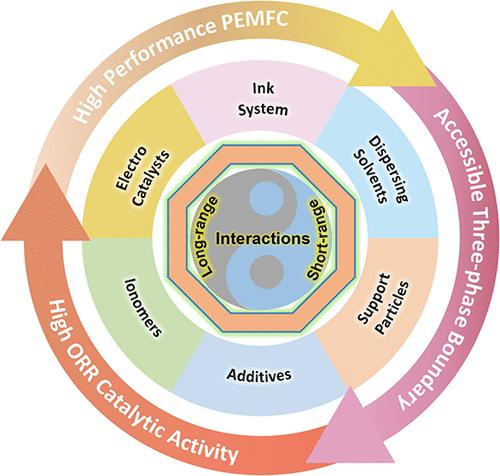Tailoring Electrocatalyst–Ionomer Coupling for High-Performance PEM Fuel Cells via Optimizing Long/Short-Range Interactions
IF 13.1
1区 化学
Q1 CHEMISTRY, PHYSICAL
引用次数: 0
Abstract
Dispersing solvent is an exclusive mediator to tailor solvent–electrocatalyst–ionomer coupling dynamics and further proton exchange membrane fuel cell (PEMFCs) performance. On one hand, this coupling tailors the nucleation and subsequent growth dynamics of electrocatalyst–ionomer aggregates, determining the diffusion pathway as well as electron/proton-conduction continuity. On the other hand, this coupling controls the accessibility and local structure of the triple-phase boundary, affecting the amounts of active centers and local O2 transport resistance. Therefore, unveiling the relationship between ink composition and electrocatalyst–ionomer coupling at short/long range improves electrochemical reaction dynamics and facilitates construction of high-performance membrane electrode assemblies (MEAs). In this review, the regulation mechanism of solvent–electrocatalyst–ionomer coupling and performance enhancement are systematically summarized. Also, the composition effect including the physiochemical property of solvents, molecular morphology of ionomers, and structure of electrocatalysts is sufficiently unveiled by analyzing oxygen-transport impedance and accessibility of triple-phase boundary. Meanwhile, the design principle for structurally matching solvents, ionomers, and electrocatalysts is also presented on the basis of short-range and long-range interactions. This review provides a guideline for constructing high-performance MEA via electrocatalyst–ionomer–solvent coupling modulation.

通过优化长/短程相互作用,定制高性能PEM燃料电池的电催化剂-离聚体耦合
分散溶剂是调节溶剂-电催化剂-离聚体耦合动力学和进一步提高质子交换膜燃料电池(pemfc)性能的唯一介质。一方面,这种耦合调整了电催化剂-离聚体聚集体的成核和随后的生长动力学,决定了扩散途径以及电子/质子传导的连续性。另一方面,这种耦合控制了三相边界的可达性和局部结构,影响了活性中心的数量和局部O2输运阻力。因此,揭示油墨成分与电催化剂-离聚体在近距离/长距离耦合之间的关系,可以改善电化学反应动力学,促进高性能膜电极组件(MEAs)的构建。本文系统地综述了溶剂-电催化剂-离聚体偶联的调控机理及性能的提高。此外,通过分析氧传递阻抗和三相边界可达性,充分揭示了溶剂的理化性质、离聚物的分子形态和电催化剂的结构等组成效应。同时,提出了基于近程和远程相互作用的溶剂、离聚体和电催化剂结构匹配的设计原则。本文综述了通过电催化剂-离聚体-溶剂耦合调制构建高性能MEA的方法。
本文章由计算机程序翻译,如有差异,请以英文原文为准。
求助全文
约1分钟内获得全文
求助全文
来源期刊

ACS Catalysis
CHEMISTRY, PHYSICAL-
CiteScore
20.80
自引率
6.20%
发文量
1253
审稿时长
1.5 months
期刊介绍:
ACS Catalysis is an esteemed journal that publishes original research in the fields of heterogeneous catalysis, molecular catalysis, and biocatalysis. It offers broad coverage across diverse areas such as life sciences, organometallics and synthesis, photochemistry and electrochemistry, drug discovery and synthesis, materials science, environmental protection, polymer discovery and synthesis, and energy and fuels.
The scope of the journal is to showcase innovative work in various aspects of catalysis. This includes new reactions and novel synthetic approaches utilizing known catalysts, the discovery or modification of new catalysts, elucidation of catalytic mechanisms through cutting-edge investigations, practical enhancements of existing processes, as well as conceptual advances in the field. Contributions to ACS Catalysis can encompass both experimental and theoretical research focused on catalytic molecules, macromolecules, and materials that exhibit catalytic turnover.
 求助内容:
求助内容: 应助结果提醒方式:
应助结果提醒方式:


